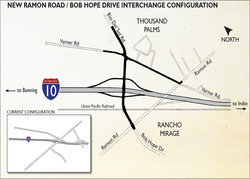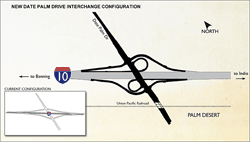Transportation Projects
Jefferson Street – Construction Expected February 2014
The Jefferson Street project will demolish the existing bridge and northbound Indio Boulevard overcrossing and replace it with a new six-lane bridge with bicycle lanes on each side and sidewalk on northbound side of Jefferson Street. It will also realign and widen portions of Varner Road and add traffic signals at the ramps and intersection of Jefferson Street and Varner Road. This project is estimated to create 500 new jobs over the life of the project.

Mecca Downtown Street Revitalization – Phases Two and Three Complete
The Mecca Downtown Street Revitalization plan comprises construction of approximately seven miles of street, sidewalk, curb and gutter, and street light improvements for fifteen streets within the 1.3 square-mile downtown area. These are all basic infrastructure amenities that were lacking in Mecca.
This extensive $22 million renovation project will be completed in several phases, with the first phase completed in May 2010. Phase two started construction in January 2011. Planning for this project began in October 2004, with the project’s guiding principles established in November 2007.
Phase one construction began in October 2009 and included roadway, sidewalk and street light enhancements along Second Street.

Completed Coachella Valley Interstate 10 Corridor Projects: Bob Hope Drive/Ramon Road – Bob Hope Bridge Dedicated Sept. 23, 2011
The Bob Hope Drive/Ramon Road interchange was opened shortly after the dedication of the Bob Hope Bridge on Sept. 23, 2011. The $25.5 project extends Bob Hope Drive to Varner Road with a new eight-lane bridge over Interstate 10 with new on- and off-ramps.
Originally projected to cost $38 million, the project received $23.5 million in stimulus funds, with other funding comes from the Interstate Maintenance Discretionary Fund and the Transportation Uniform Mitigation Fund (TUMF). Caltrans began construction on the interchange on Feb. 3, 2010 and created an estimated 500 jobs.

Indian Canyon Drive – Dedicated March 9, 2012
The Indian Canyon interchange was completed March 9, 2012. The $16.5 million project, of which $5.5 million were ARRA funds, replaced the original overcrossing with a six-lane overcrossing, including bike lanes on each side. The project also widened portions of 20th Avenue and Garnet Avenue, improving traffic signals, storm drainage and freeway vertical clearance.
Construction on the Indian Canyon interchange began in August 2010 and created an estimated 350 jobs.

Palm Drive/Gene Autry Trail – Dedicated March 9, 2012
The Palm Drive/Gene Autry Trail interchange was completed March 9, 2012. The $17 million project realigned ramps and replaced the original two-lane overcrossing with a six-lane overcrossing and bike lanes on each side, in combination with widening Gene Autry Trail Bridge over the Union Pacific Railroad tracks. Micro Place and Salvia Roads were also realigned as part of this project.
Originally projected to cost $33 million, the project received $10.4 million in American Recovery and Reinvestment Act (ARRA) funds. Other funding sources included Federal Highway Administration Funds - DEMO, Transportation Uniform Mitigation Fund, Measure A and funds from the County of Riverside and cities of Desert Hot Springs, Palm Springs and Cathedral City. Construction on the Palm Drive/Gene Autry Trail interchange began in March 2010 and created an estimated 350 jobs.

Date Palm Drive – Scheduled Completion January 2014
Construction on the Date Palm Drive Interchange Improvement Project began May 13, 2011 and is scheduled to be substantially completed in January 2014.
The fourth of six interchange projects on Interstate 10 in the Coachella Valley, this project will widen the existing Date Palm Drive overcrossing on each side to provide a six-lane overcrossing that includes bike lanes in both directions. Other improvements include new loop on-ramps from northbound Date Palm Drive to westbound I-10 and from southbound Date Palm Drive to eastbound I-10. The remaining ramps will be realigned with two lanes, which will reduce congestion and help improve air quality.
Riverside County awarded the $14.8 million project to SEMA Construction, Inc. of Lake Forest, Calif., a competitive bid that came in $4.6 million, or 23.8 percent, below the engineer’s estimate. This project is estimated to create 350 new jobs over the life of the project.

Mecca Roundabout Street Improvement Project – Ribbon-Cutting at 2 p.m.
Thursday, February 21, 2013 Riverside County’s newest roundabout is providing drivers a safer, more efficient and smoother flow through Mecca’s main intersection at Fourth Street and Hammond Road.
Supervisor John J. Benoit is welcoming the public to attend the ribbon cutting of the Mecca roundabout to be held at 2 p.m. Thursday, Feb. 21, 2013, which will feature the unveiling of a decorative entry monument mural with the Mecca community logo.
“Roundabouts are gaining popularity in Southern California because they improve the flow of traffic and increase safety, and this intersection was ripe for one,” said Supervisor John J. Benoit. “The roundabout greatly enhances the primary entrance into Mecca, a community that has seen a dramatic transformation as a result of $55 million in county investment.”
The single-lane roundabout keeps traffic moving efficiently around a central island, without stop signs or traffic signals. The design requires merging drivers from Fourth Street and Hammond Road to yield to drivers in the circulating roadway of the roundabout.
In addition to the Mecca roundabout which opened to traffic in December 2012, in Riverside County, there are two, multi-leg two-lane roundabouts by the Morongo Casino Resort & Spa in Cabazon, two in La Quinta (Old Town La Quinta and Jefferson Street and Avenue 52) and one in the Temecula Valley’s Wine Country area at Rancho California and Anza roads.
The roundabout is the reconfiguration of a complex four-way intersection adjacent to a railroad crossing. The roundabout accommodates the estimated 9,000 daily vehicles and peak-hour traffic of more than 1,200 vehicles. This entry is used by residents, agricultural businesses, commercial trucks and tourists traveling to the Painted Canyon.
The roundabout accommodates oversize vehicles, including commercial trucks common to this agricultural community, with a truck apron that allows the trucks’ rear wheels to ride up on a raised section of stamped concrete around the central island.
The aesthetic entrance to Mecca is also improved with palm trees, some landscaping, decorative walls, an entry monument installed as part of the project as well as new street lights. The $2.945 million project was funded by $2 million in Congestion Mitigation Air Quality Funds, with the remainder by redevelopment.
Fred Waring Widening
 The conceptual plan for the preferred alternative for Fred Waring can be viewed here.
The conceptual plan for the preferred alternative for Fred Waring can be viewed here.
Monterey Avenue – Construction Expected Spring 2014
 In spring 2014, construction is expected to start on the Monterey interchange project. This will modify on and off-ramps and create 150 new jobs over the life of the project.
In spring 2014, construction is expected to start on the Monterey interchange project. This will modify on and off-ramps and create 150 new jobs over the life of the project.


